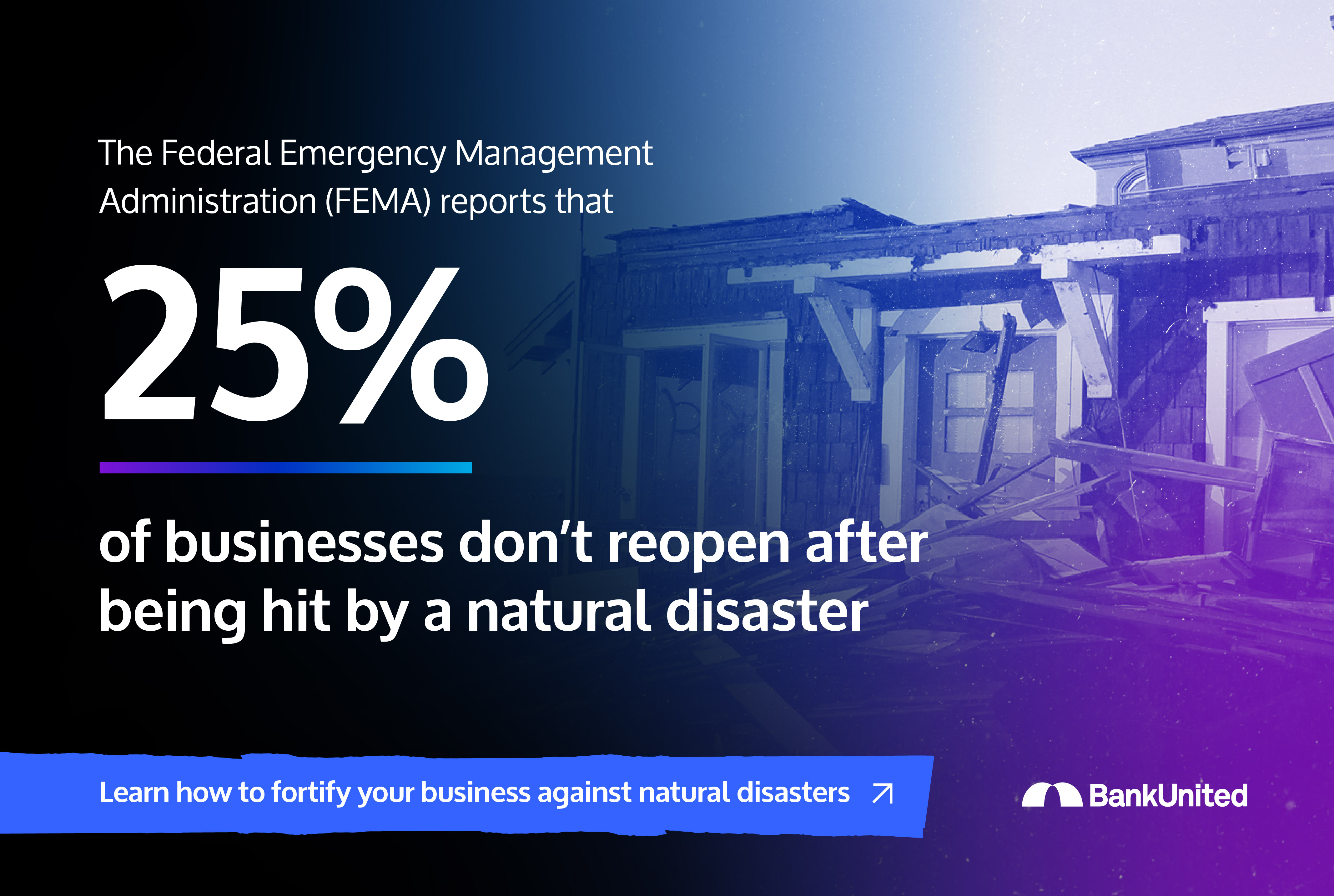For too many businesses, getting hit by a natural disaster is more than just a hassle or unexpected financial drain. It’s the end. The Federal Emergency Management Administration (FEMA)
estimates that about a quarter of businesses never reopen after a natural disaster, like a hurricane, tornado, or wildfire.
In an
earlier article, we outlined critical steps businesses should take before an extreme weather event to safely and successfully navigate a storm and continue operating as smoothly as possible afterward.
Actions to bolster your company’s resilience before a storm include:
- Understanding what your insurance does and does not cover
- Developing business continuity plans
- Securing critical documents
- Establishing an emergency savings account
- Ensuring access to digital and mobile banking
Advanced planning matters, but so does an effective recovery
It’s no exaggeration to say that advanced planning can be the difference between your business bouncing back quickly after a natural disaster or closing its doors for good. But it’s also true that how your business responds during the recovery phase after a storm – especially financially – will determine how well you’ll be positioned for long-term success.
Quick access to funds is essential. In early June 2024, for instance, the National Oceanic and Atmospheric Administration (NOAA)
reported there had been 15 extreme weather events causing over $1 billion in damage. Data like this can seem abstract, but what it means for business owners is the steep price tag they may face in repairing, rebuilding, or finding entirely new offices, warehouses, and storefronts.
To put it more simply, it comes down to finding the necessary cash to pay for rebuilding and to cover potential cash flow shortfalls. An effective response to business disruptions caused by a natural disaster requires knowing where and how to seek funding and knowing how to access it quickly.
It’s unlikely that all the funding your business may need to recover will come from the same source. And what you’ll be able to access will depend partly on the advanced planning and saving you do before a storm impacts your company. But here are a few options you’ll want to pursue to get your business back to normal quickly:
Insurance
The point of insurance is to cover expenses associated with unusual and unexpected events, including natural disasters. A critical step to improve your company’s resilience to extreme weather is to fully grasp what your property and business interruption insurance policy does and does not cover. In the recovery phase, however, you want to move quickly and proactively to file a claim. Remember, there will be a lot of businesses doing the exact same thing, so the faster you can survey the damage and file a claim, the better. What can also help process the claim and get critical funds quickly is to be ready with the information and documentation overwhelmed insurance adjusters need to do their job. Providing before and after photos of office equipment damaged, ownership deeds, and other proof of losses will speed the disbursement of the money you need to rebuild and continue operations.
Savings
Even the most efficient insurance claim process will still include delays in accessing funds. That is not the case if your company has set aside money in a dedicated savings account to financially support recovery and business interruption. If you
download the BankUnited app, you’ll still be able to continue paying bills and salaries even if a storm is harsh enough to prevent you from reaching ATMs and bank branches. And if you take advantage of BankUnited’s
savings accounts and are diligent about setting money aside for an emergency, you’ll have more recovery funds available to accelerate your recovery to business normalcy.
Government Funding
The U.S. Small Business Administration (SBA) understands that natural disasters can be a financial burden for many small companies. To help companies recover and rebound, the SBA offers disaster recovery
loans. To be eligible, companies must be in a federally designated
disaster area. The low-interest, long-term loans can be used to repair or replace damaged physical property and assets, as well as to cover expenses when a company must suspend operations. The SBA website makes it simple to determine eligibility for financing and allows business owners to track their applications online.
Partner With Your Bank
Any business owner can tell you that forging a collaborative relationship with their bank is a key ingredient for success. Under normal conditions, that is true because bankers can help businesses navigate their financing and banking needs. The aftermath of a natural disaster is anything but normal, and it’s a time when a strong relationship with your bank can help get your company back to normal operations fast. With competitive rates and quick turnaround times on loans, BankUnited can provide the funds you need to rebuild and recover rapidly. BankUnited’s full suite of
treasury solutions – including payment processing, accounts payable and receivables – can keep the financial operations of your company running smoothly even while you focus on recovery and rebuilding.
No business owner can fully anticipate, let alone control, how an extreme weather event will disrupt their business. But businesses can control both their preparation and their response. By planning carefully and being smart and decisive about accessing funding after a storm, companies can recover and get back to business quickly.


